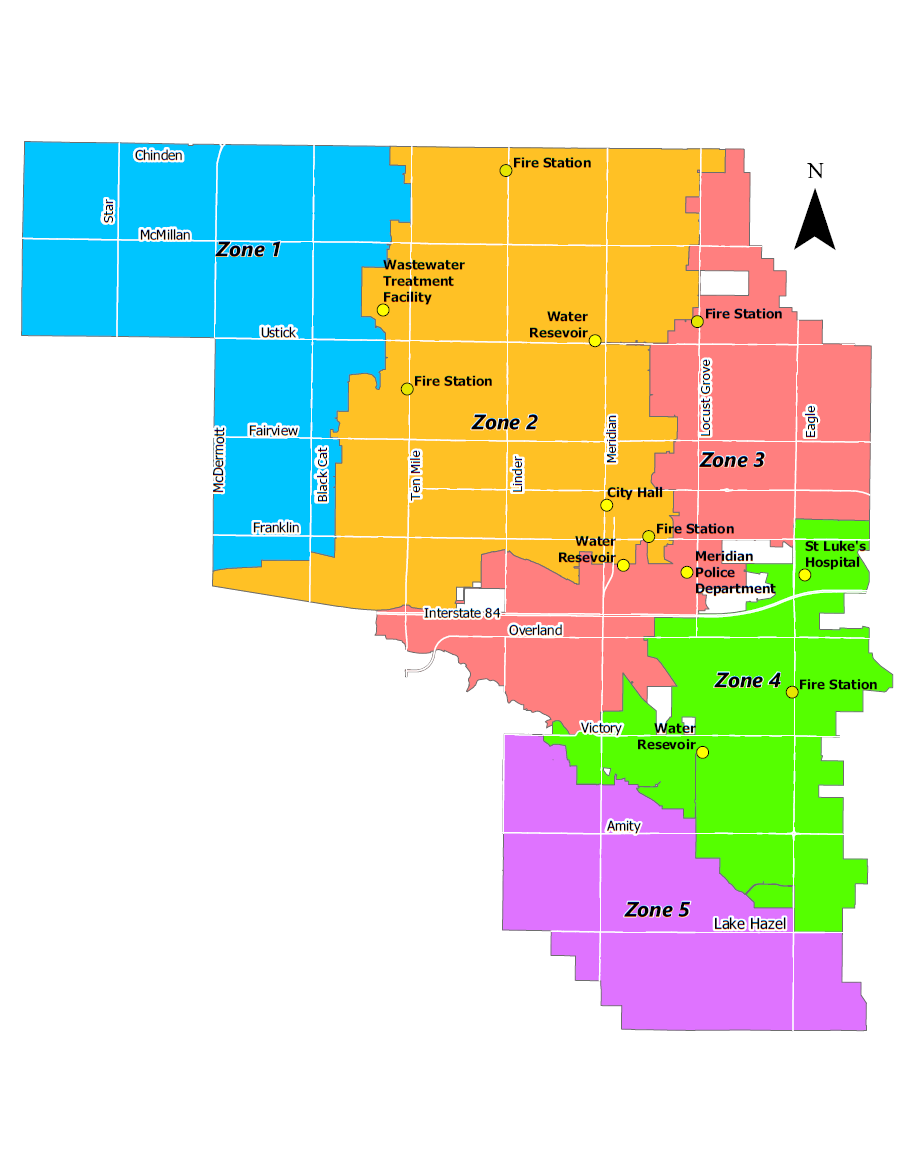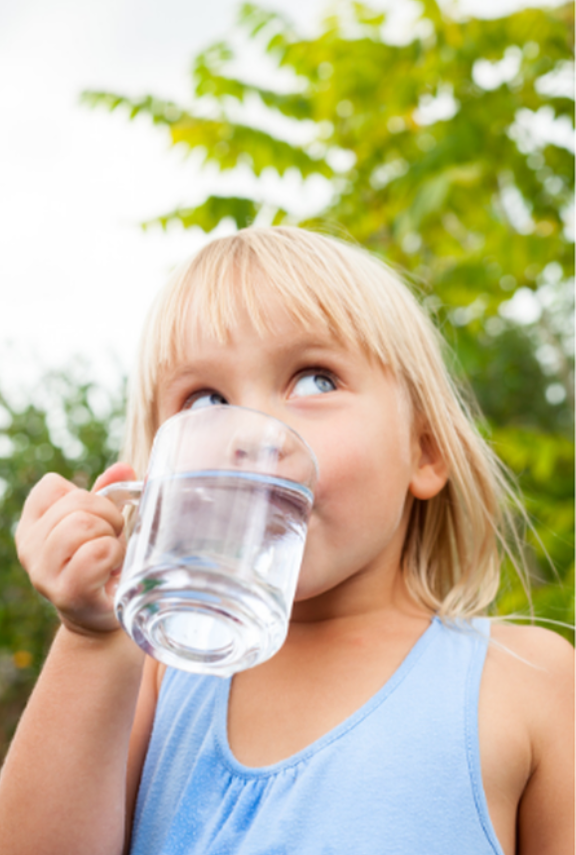Water Quality - 2019 Water Report
Water Quality

Find Your Zone to See Your Water Quality
If you are installing a water softener, aquarium, pool, home brewing beer, or require certain water quality for your individual operation, please use this chart for your setup needs. Roughly locate where you are on the map and use the corresponding chart below to answer your water quality needs. If you have additional water quality questions, please feel free to contact us!

A hard copy report of Meridian water quality can be picked up at the Meridian Water Division and Meridian City Hall.
We routinely monitor for contaminants in your drinking water according to Federal, State, and local standards. The State of Idaho requires us to monitor for certain contaminants less than once per year because the concentrations of these contaminants are generally stable, not expected to vary from year to year, or the system in not considered vulnerable to this type of contamination. Therefore, some of our data, though representative, may be more than one year old. These tables show the results of monitoring for the period of January 1st to December 31st, 2019, unless otherwise noted. For more information about this report, or any questions relating to your drinking water, please contact us.
If you are installing a water softener, aquarium, pool, home brewing beer, or require certain water quality for your individual operation, please use this chart for your setup needs. Roughly locate where you are on the map and use the corresponding chart below to answer your water quality needs. If you have additional water quality questions, please feel free to contact us!
Water Quality by Zone
| ZONE 1 | ZONE 2 | ZONE 3 | ZONE 4 | ZONE 5 | |
|---|---|---|---|---|---|
| Hardness mg/L | 160.00 | 103.57 | 147.70 | 142.00 | 145.25 |
| Hardness (Grains) | 9.36 | 6.06 | 8.64 | 8.30 | 8.49 |
| pH | 7.45 | 7.82 | 7.30 | 7.47 | 7.61 |
| Sodium (PPM) | 16.00 | 16.71 | 32.10 | 78.00 | 54.50 |
| Total Dissolved Solids (PPM) | 240.00 | 191.43 | 275.00 | 376.00 | 340.00 |
Meridian Water Quality Data
INORGANIC CONTAMINANTS
Results Reported in Milligrams per Liter (mg/L)
| Contaminant | Violation | MCL | MCLG | Lo Level Detected | Hi Level Detected | 2019 Test Date | Likely Source of Contamination |
|---|---|---|---|---|---|---|---|
| Arsenic | No | 0.01 | 0 | No detection | 0.0042 | December | EROSION OF NATURAL DEPOSITS; RUNOFF FROM ORCHARDS |
| Atrazine | No | 0.003 | 0.003 | No detection | 0.000078 | December | RUNOFF FROM HERBICIDE USED ON ROW CROPS |
| Barium | No | 2 | 2 | No detection | 0.071 | April | EROSION OF NATURAL DEPOSITS |
| Nitrate (as Nitrogen) | No | 10 | 10 | No detection | 4.2 | May | EROSION OF NATURAL DEPOSITS |
Radionuclides
Results Reported in Picocuries per Liter (pCI/L) or Milligrams per Liter (mg/L)
| Contaminant | Violation | MCL | MCLG | Lo Level Detected | Hi Level Detected | 2019 Test Date | Likely Source of Contamination |
|---|---|---|---|---|---|---|---|
| Gross Alpha Particle Activity (pCi/L) | No | 15 | 0 | No detection | 4.6 | January | EROSION OF NATURAL DEPOSITS |
| Combined Radium (pCi/L) | No | 5 | 0 | No detection | 1.32 | January | EROSION OF NATURAL DEPOSITS |
| Uranium (mg/L) | No | 0.030 | 0 | No detection | 0.023 | April | EROSION OF NATURAL DEPOSITS |
Disinfection By-Products
Reported in Milligrams per Liter (mg/L)
| Contaminant | Violation | MCL | MCLG | Lo Level Detected | Hi Level Detected | 2019 Test Date | Likely Source of Contamination |
|---|---|---|---|---|---|---|---|
| Haloacetic Acids (5) (HAA5s) | No | 0.060 | N/A | No detection | 0.001 | June | BY-PRODUCT OF DRINKING WATER DISINFECTION |
| Total Trihalomethanes (TTHMs) | No | 0.080 | N/A | No detection | 0.0083 | November | BY-PRODUCT OF DRINKING WATER DISINFECTION |
| Chlorine Residual | No | 4.000 | 4 | 0.5 | 0.813 | October | WATER ADDITIVE USED TO CONTROL MICROBES |
Microbiological
| Contaminant | Violation | MCL | MCLG | Highest % Positive in a Month | Total Number Positive | Likely Source of Contamination |
|---|---|---|---|---|---|---|
| Total Coliform Bacteria | No | <5% | 0 | 0 | 0 | NATURALLY PRESENT IN THE ENVIRONMENT |
Lead and Copper
Reported in Milligrams per Liter (mg/L)
| Contaminant | Violation | 90th Percentile Action Level | MCLG | Lo Level Detected | Number of Sites Above Action Level | 2019 Test Date | Likely Source of Contamination |
|---|---|---|---|---|---|---|---|
| Copper | No | 0.071 | 1.3 | No detection | 0 | October | "CORROSION OF HOUSEHOLD PLUMBING SYSTEMS; EROSION OF NATURAL DEPOSITS |
| Lead | No | 0.003 | 0 | No detection | 3 | October | "CORROSION OF HOUSEHOLD PLUMBING SYSTEMS; EROSION OF NATURAL DEPOSITS |
Definitions to Help Understand Abbreviations Used in this Report
(AL) Action Level: The concentration of a contaminant that, if exceeded, triggers treatment or other requirements that a community water system shall follow.
(HAA) Haloacetic Acids: By-products created when disinfectants used to treat water react with organic and inorganic material in source water.
(MCL) Maximum Contaminant Level: The highest level of contaminant that is allowed in drinking water. MCLs are set as close to the MCLGs as feasible using the best available treatment technology.
(MCLG) Maximum Contaminant Level Goal: The level of contaminant in drinking water below which there is no known or expected risk to health. MCLGs allow a margin of safety.
(THM) Trihalmoethanes: Chemical compounds that can be formed when water is disinfected with chlorine.
Primary Standards: Federal drinking water regulations for substances that are health related. Water suppliers must meet all primary drinking water standards.
Secondary Standards: Federal drinking water measurements for substances that do not have an impact on health. These reflect aesthetic qualities such as taste, odor and appearance. Secondary standards are recommendations, not mandates
Lead-Free Water
Lead is a naturally occurring element found in small amounts of the Earth's crust. Elevated levels of lead in humans can cause serious health problems, especially for pregnant women and young children. Lead occurrence in drinking water is primarily from materials and components associated with water service lines and home plumbing fixtures. Lead can enter drinking water through corrosion of plumbing materials, especially where the water has high acidity or low mineral content. Meridian's water source wells contain no traces of lead.
Meridian proactively samples for and monitors concentrations of lead in our drinking water. Samples are taken regularly at random houses throughout the City constructed during the time frames lead was used in plumbing. Results are shared with homeowners and reported to Idaho Department of Environmental Quality (IDEQ). Looking forward, we will continue to sample and monitor for lead.
Although the City of Meridian is responsible for providing high quality drinking water, it cannot control the variety of materials used in plumbing components. If you reside in a residence where you feel lead plumbing components have been used, minimize your exposure by flushing your tap for 30 seconds to 2 minutes before drinking or using for cooking. If you are concerned about lead in your water you may wish to have your water tested. Information on lead in drinking water, testing methods and steps you can take to minimize exposure is available from the Safe Drinking Water Hotline or the EPA.











